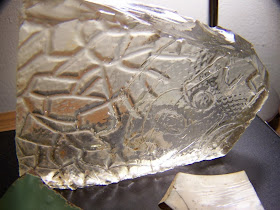 |
| Expired property listing |
 |
| EPrata photo |
| EPrata photo |
There was a lot of it. There was so much, I actually got tired of picking it up. Little did I know how rare it is.
Here is Wikipedia on sea glass-
"There is only one true type of "genuine sea glass" that can be produced and that is by the sea naturally. Pieces of glass from broken bottles, broken tableware or even shipwrecks are rolled and tumbled in the ocean for years until all of their edges are rounded off, and the slickness of the glass has been worn to a frosted appearance."
'My' sea glass is in various states of finished tumbling. One or two pieces were totally rounded and quite frosted by the ocean's wave action and the salt. Others had sharper edges but their colors let me know they were indeed older pieces of glass.
Extremely rare colors include gray, pink (often from Great Depression-era plates), teal (often from Mateus wine bottles), black (older, very dark olive green glass), yellow (often from 1930s Vaseline containers), turquoise (from tableware and art glass), red (often from old Schlitz bottles,[4] car tail lights, dinnerware or from nautical lights, it is found once in about every 5,000 pieces), and orange (the least common type of sea glass, found once in about 10,000 pieces). These colors are found once for every 1,000 to 10,000 pieces collected. Some shards of black glass are quite old, originating from thick eighteenth-century gin, beer and wine bottles.
 |
| EPrata photo |
"The most common colors of sea glass are kelly green, brown, and white (clear). These colors come from bottles used by companies that sell beer, juices, and soft drinks. The clear or white glass comes from clear plates and glasses, windshields, windows, and assorted other sources."
 |
| EPrata photo |
Less common colors include jade, amber (from bottles for whiskey, medicine, spirits, and early bleach bottles), golden amber or amberina (mostly used for spirit bottles), lime green (from soda bottles during the 1960s), forest green, and ice- or soft blue (from soda bottles, medicine bottles, ink bottles, and fruit jars from the late 19th and early 20th centuries, windows, and windshields). These colors are found about once for every 25 to 100 pieces of sea glass found.
 |
| EPrata photo |
Uncommon colors of sea glass include a type of green, which comes primarily from early to mid-1900s Coca-Cola, Dr Pepper, and RC Cola bottles as well as beer bottles. Soft green colors could come from bottles that were used for ink, fruit, and baking soda. These colors are found once in every 50 to 100 pieces.
 |
| EPrata photo |
Purple sea glass is very uncommon, as is citron, opaque white (from milk glass), cobalt and cornflower blue (from early Milk of Magnesia bottles, poison bottles, artwork, and Bromo-Seltzer and Vicks VapoRub containers), and aqua (from Ball Mason jars and 19th century glass bottles). These colors are found once for every 200 to 1,000 pieces found.
 |
| EPrata photo |
I found other kinds of ceramics besides just glass.
The color of sea glass is determined by its original source. Most sea glass comes from bottles, but it can also come from jars, plates, windows, windshields, ceramics or sea pottery.
 |
| EPrata photo |
 |
| EPrata photo |
In all, the sea is a treasure and the sea yields up treasures. Whether it's sea glass from Lubec Maine, rounded granite and rhyolite rocks from Jasper Beach Maine, or shark's teeth from Venice Beach Florida, or fossils from the Peace River in Florida, or conch shells from the Bahamas, or giant scallop shells from Labrador Canada... No matter what beach I've walked, I've always enjoyed the scenery, but mostly, I'm looking down at the sand to search for treasures!
Source Wikipedia

I love searching for sea treasures, I'm always annoyed when I agree to go beach-walking with girlfriends, and they want to fellowship but I want to go off on my own scanning the beach for treasures! Ha!
ReplyDeleteIt's my favorite part, too. I like wandering down the beach with my nose pointed down. I like the solitude also. I rarely go with friends :)
ReplyDeleteI concur! ��
Delete